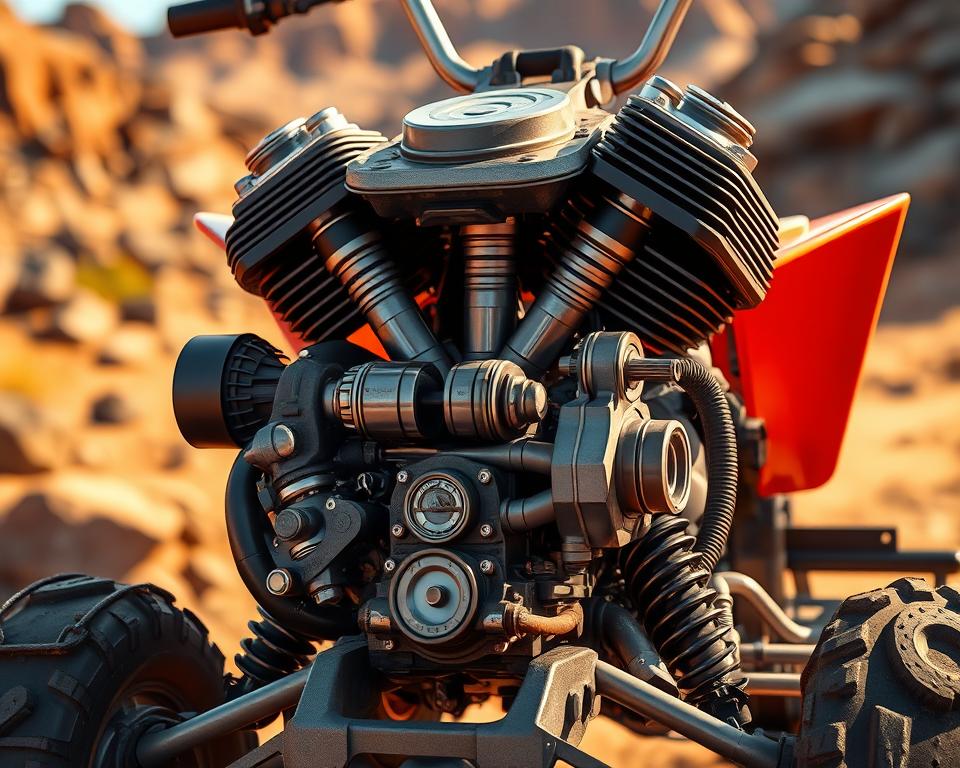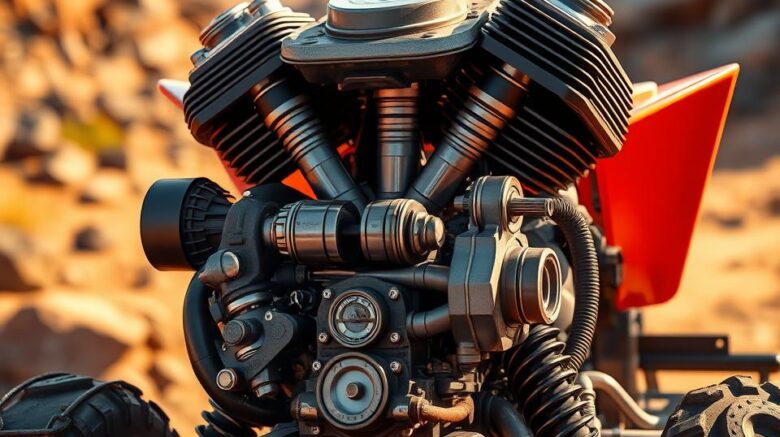Steering Clear of ATV/UTV Gearing Errors for Novices
Are you aware that nearly 35% of new ATV and UTV owners face gear selection issues within their first year? This statistic underlines the importance of grasping ATV gear ratios for beginners. Correct gear choice protects against accidents as well as enhances power. We’ll explore common mistakes, maintenance practices, and expert Motohavok advice to improve your off-road adventures.
Main Points

- Knowing gear ratios is crucial for peak off-road power.
- Common gearing oversights can lead to safety risks on the trails.
- Regular maintenance is key to preventing UTV transmission issues.
- Proper gear selection greatly enhances off-road riding experiences.
- Applying service recommendations increases longevity.
Understanding ATV and UTV Gear Ratios
Gear ratios are vital for the performance of ATVs and UTVs. They govern both top speed and hauling capacity. That impacts hill climbs and tow capabilities. By picking specific ratios, you tailor your ride for drag, trail, or work.
Selecting proper gears unlocks engine potential. Excessively low gearing reduces hill-climbing pull. Overgearing sacrifices quickness for top-end speed.
Riders often tweak reduction ratios for trail versatility. Tuning ratios lets you fine-tune speed vs. torque. It lets you balance acceleration with pulling force. Finding the sweet spot in gearing enhances ride quality and fuel economy.
Common Gearing Oversights for New ATV/UTV Owners
Correct gearing secures top output and trail safety. Many new owners overlook critical aspects of gear selection. Knowing what happens when you misgear and how to fix it transforms your experience. And it sidesteps needless breakdowns.
Impact of Incorrect Gear Selection
Misgearing risks crashes and costly damage. The wrong gear can slow down acceleration, affect braking, and cause excessive wear. These mishaps compromise safety for all on and off board. Using maintenance best practices wards off these hazards.
Choosing the Right Gear for Terrain
Different terrains need different gearing for efficient performance. Climbing requires low-end grunt from smaller ratios. To cover ground quickly, shift to higher ratios. Soft ground demands careful gear choice for grip. Knowing these environmental factors is critical for safe and enjoyable off-road adventures.
The Importance of Proper ATV Maintenance
Regular maintenance is key to keeping ATVs and UTVs running smoothly. Following ATV maintenance tips helps avoid unexpected breakdowns and boosts safety. A well-planned maintenance schedule focuses on the gear system’s health.
Regular Inspection and Maintenance
A detailed inspection checklist is essential for spotting issues early. Routinely examine gearbox teeth, brake pads, rubber, and belts. Routine checks lead to peak performance. Here are some critical inspection points to remember:
- Examine gear alignment and wear.
- Ensure all fasteners are tight.
- Assess brake fluid and hydraulic systems.
- Measure wheel pressure and wear.
- Review electrical systems for corrosion.
Fluid Changes and Gear Health
Clean fluids keep transmissions and differentials happy. Frequent changes clear out contaminants. Clean fluids ensure smoother operation and reduce friction, extending the life of vital parts. Adopting this routine preserves drivetrain health and trail readiness.
| Fluid Type | Recommended Change Interval | Benefits of Regular Change |
|---|---|---|
| Engine Oil | Every 50-100 hours | Reduces engine wear, enhances performance |
| Differential Oil | Every 100-200 hours | Improves shifting, minimizes gear damage |
| Antifreeze | Once per year | Stops boil-overs and freezes |
By following these guidelines, enthusiasts can enjoy their rides without worrying about mechanical failures. This makes every journey more enjoyable.
Common ATV Gear Shifting Problems
New ATV riders often face challenges with gear shifting. Mastering smooth shifting techniques can greatly improve the riding experience. This stops shift-related aggravation. Proper coordination of the throttle and clutch is key for control and avoiding shifting problems.
Learning to Shift Smoothly
Developing smooth shifting techniques requires a few practices. Start by getting to know your ATV engine’s rhythm. Gentle shifts spare your gearbox and extend service life. Blending throttle with clutch release ensures seamless shifts.
Drill shifts in an open space to build skill. Keep your throttle light when shifting.
Recognizing Signs of Gear Issues
Early detection of gear issues is essential. Be alert for clicks, clunks, or grinds when shifting. Stuck gears or false neutrals are warning signs. Fixing problems fast keeps you safer on the trail. Correcting misgears sustains reliability and your enjoyment.
Understanding UTV Transmission Issues
UTV gearbox troubles challenge many owners, so familiarity helps diagnose. Owners often face issues like slipping gears or odd noises. Below we break down common failures and the tools to troubleshoot them. Drawing on proven UTV repair protocols.
Diagnosing Common Problems
Recognizing the signs of transmission troubles is essential. Common issues include:
- Slipping gears that threaten control and safety.
- Strange noises signaling internal wear.
- Leaking transmission fluid, potentially leading to more severe problems.
Regular gear diagnostics help spot these issues quickly. It lets you fix faults before they worsen. Missing early clues damages your ride and wallet.
Solutions for Troubleshooting UTV Transmissions
Fixing UTV transmission issues requires a systematic approach. Follow these steps for effective troubleshooting:
- Check fluid levels and top up if necessary.
- Examine for any leaks under the vehicle.
- Open housing to check bearings and gears.
- Test drive the UTV at various speeds to monitor gear engagement and responsiveness.
- Check OEM guides for model-specific repair advice.
Leveraging a proven guide speeds up repairs. Understanding gear mechanics is key for any UTV owner. This knowledge boosts lifespan and performance.
ATV Clutch Adjustments and Their Benefits
Right clutch settings smooth out gear changes. Bad clutch setup leads to gear grind and confusion. Routine calibration refines clutch response and engagement.
Precision in gear changes is critical. An optimally adjusted clutch ensures quick and smooth gear changes. It refines acceleration and comfort across all conditions.
Ignoring clutch adjustments can harm performance and wear out parts. Consistent adjustments sustain peak clutch function. It’s critical for both new and seasoned riders to ensure their ATV performs at its best.
Mastering the Art of Gear Shifting
Becoming adept at shifts transforms your off-road sessions. It requires knowledge of your vehicle’s mechanics and developing a keen sense of timing and spatial awareness. Rookies need to practice gear timing. A comfortable cadence leads to smoother transitions and improved performance.
Skillful shifting comes from drilling in diverse environments. Knowing shift points for hills, flats, and mud secures handling. For instance, shifting down when approaching a steep hill helps maintain power and stability.
- Rehearse clicks slowly to gain control.
- Observe how your vehicle responds to different shifts.
- Gradually incorporate more challenging terrains to test your skills.
Getting in sync with your ride ensures perfect shifts. Listen for pitch changes and shudders to guide engagements. This helps determine the optimal moments to shift. Such intuitive understanding leads to proficient gear shifting, making your ride more enjoyable.
Best Practices for UTV Gear Selector Problems
Managing UTV gear selector problems demands a proactive maintenance and diagnostic approach. Routine linkage reviews catch wear promptly. By mastering gear selection techniques, operators can avoid malfunctions. Check shifter arms and oil levels with each maintenance session.
If you suspect a fault, inspect the lever assembly for bends or breaks. Unusual noises can also hint at problems. Minor tweaks typically fix selector snags. Scheduled servicing prevents selector degradation.
Tracking shift quality across terrains isolates faults. Following these methods preserves selector health and rider trust.
Tips for Enhancing Gear Performance
Achieving top drivetrain function demands regular attention. Routine service boosts ATV efficiency. Verify oil levels, examine parts, and tweak calibrations. Spotting wear early stops expensive overhauls.
Choosing the right gear ratios is essential for maximizing engine response and achieving a smoother ride. Knowing trail types steers your ratio choices. It influences your launch and maximum velocity. Seeking parts from specialists such as American Off-Roads aids in UTV performance enhancements.
Applying gear performance tips across tires, shocks, and load balance boosts efficiency. Making these adjustments ensures that both ATVs and UTVs handle better in challenging environments. You’ll notice more thrill and less stress on every trip. By using these methods, you’ll tackle trails boldly and relish every moment.
To Conclude
Mastering ATV/UTV gearing is essential for performance and safety. Matching gears to ground types transforms your adventure. Steering clear of rookie errors and picking wisely ensures safe, thrilling rides.
No less crucial is keeping your drivetrain in top trim. Regular checks and upkeep are key to avoiding problems and extending your vehicle’s life. Proper care boosts efficiency and keeps you safe in diverse environments.
Combining correct gearing with scheduled service delivers peak satisfaction for riders. Embracing these tips sets the stage for countless epic journeys.
Frequently Asked Questions
Common ratio ranges for ATVs/UTVs?
ATVs and UTVs have gear ratios that vary widely, depending on the model. Most fall between about 3:1 and 5:1. Smaller ratios deliver grunt for trails and climbs. Large ratios favor maximum velocity on smooth surfaces.
How can I determine if I’m using the wrong gear for my terrain?
Misgearing risks unstable handling, rev overload, or sluggish starts. Each terrain type—mud, sand, rock, or snow—requires specific gear selection for optimal performance.
How to know when your machine needs service?
Look out for signs like difficulty shifting gears, unusual noises from the transmission, fluid leaks, or a decrease in performance. Periodic drive train reviews ward off costly repairs.
When to swap your drivetrain oils?
Rotate your oils at 1.5–2.5K miles or yearly, based on how and where you ride. Fresh fluids promote crisp shifts and gearbox longevity.
How to shift gears without jerking?
Sync your revs and clutch for seamless gear changes. Feather the clutch up while winding the throttle for a perfect match.
How can I troubleshoot UTV transmission issues?
Begin with fluid level checks and a listen for whines or grinds. Inspect the transmission fluid level and condition. Then, perform a basic diagnostic to identify any mechanical failures.
Benefits of tuning your clutch?
Well-set clutches ensure crisp gear changes. Incorrect clutch setup strains the gearbox and causes sticky shifts.
Optimizing gears for varied ground?
Try different ratio setups and check out trusted upgrades from American Off-Roads. Scheduled service—linkage grease and oil changes—maintains top output.
Addressing a bad gear selector?
Regular inspections and routine maintenance are key. If you encounter issues with a stuck selector or improper gear engagement, consult the troubleshooting guide in your owner’s manual for step-by-step diagnostics.
Rookie gearing errors to dodge?
Rookies tend to ignore ratio basics, delay upkeep, or misgear for mud, rock, or hills. These mistakes hamper performance and raise the chance of mishaps.
